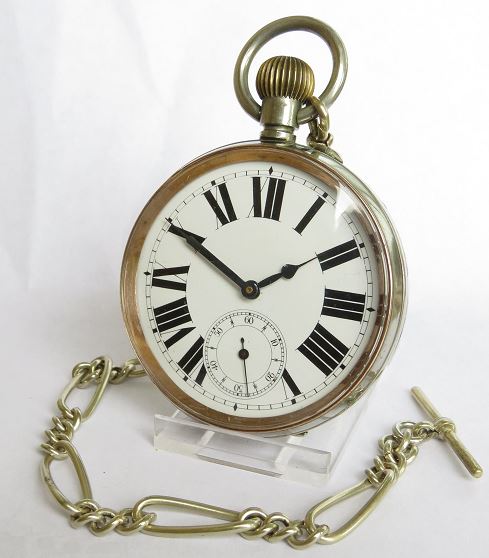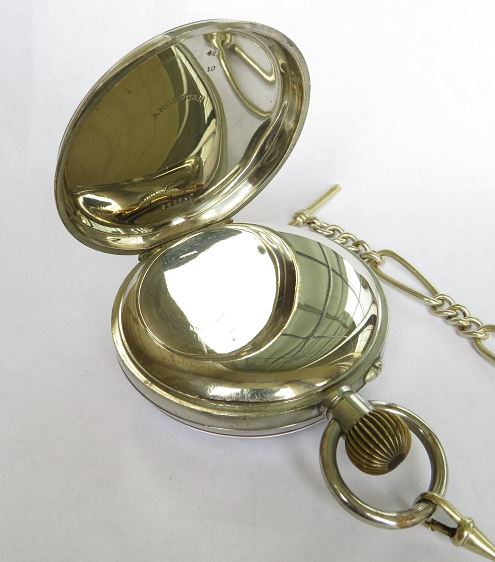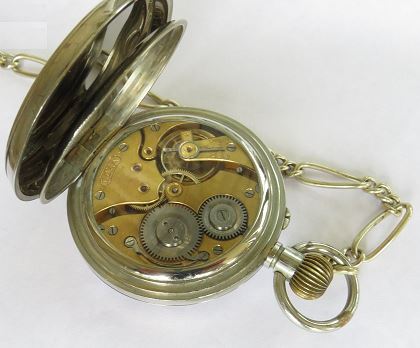Last updated on July 2, 2024
In my recent posts, I have stated that I am currently on the lookout for a hunter cased antique pocket watch. However, I am not having a great deal of luck. I guess with the worsening effects of the Coronavirus pandemic, antique watch dealers have had more important things to worry about than expanding their stock. However, the lockdown now means I have more time to spend investigating in my hobby of antique watches. Although I haven’t found my antique hunter cased watches to add to my collection, I have seen a few other antique pocket watches that have caught my eye.
Goliath pocket watches
In today’s post, I am taking a look at an antique Doxa goliath pocket watch. As the name ‘Goliath’ suggests this is a large pocket watch. I can’t find a conclusive definition of what constitutes a ‘Goliath’ pocket watch. The name ‘Goliath’ was registered by Omega in 1892 for their giant pocket watches, which had an Omega calibre 30”’ 8-day stem-winding movement. However, I have seen many other pocket watches labelled as goliaths from other brands, such as Doxa. It is possible that they all used the Omega 8-day movement, but I suspect the term ‘Goliath’ has been appropriated and applied to any large pocket watch. This is much like the brand ‘Hoover’ has been applied to vacuum cleaners in general.

Typically, antique pocket watches are around 50mm in diameter. The term goliath seems to be applied to any pocket watch with a diameter of 60mm or more. I have seen examples online which are in excess of 130mm, which I don’t imagine is very practical for carrying in a pocket. I imagine, most of these 60mm+ pocket watches fulfilled two purposes, one remaining a portable pocket watch and two, being used as a desk or tableside clock. The larger size would also allow a larger mainspring and therefore a longer power reserve. I have seen some references to these being used as clocks to be mounted on car dashboards or used by station masters as a dual-purpose watch/desk clock.
Doxa Goliath pocket watch
The Doxa Goliath pocket watch measures 65mm in diameter excluding the winding stem and the loop. The case is Argentan and it is in good condition, with just a slight indentation to the edge of the case back. Looking at the photographs the indentation is very minor and being on the case back would be barely noticeable. If anything, the slight damage, adds to the character of the watch. The watch has mineral glass, which is in good condition with no visible chips or damage. The dial is in outstanding condition with crisp, clear markings and no obvious fading. The watch has pin-set blued steel hands, with what looks like a very slight mark on the hour hand. Additionally, there is a subsidiary seconds-dial and an outer minute track.

Argentan
The inner case back is stamped Argentan, which is also known as German silver. It was not an uncommon case material in continental Europe. Argentan is an alloy with a silvery appearance that consists of copper (60%), nickel (20%) and zinc (20%). Argentan is used because of its close resemblance to silver and due to its corrosion resistance.

Movement
The movement is stamped with the maker’s name, Doxa. Georges Ducommun founded the company in 1889. Ducommun was born into a large family in Le Locle in the Jura mountains, the epicentre of watchmaking in Switzerland. Ducommun started working as an apprentice watchmaker at the age of 12. By the time he was 21, he had founded his watchmaking factory in Chateau des Monts. Ducommun died in 1936 and the company changed hands several times. It is still in existence and most notably produces a range of modern dive watches. It is difficult to tell much more about the movement without additional markings. I clearly see the regulator and several jewels, which makes me think it is a 15-jewel movement.

The watch comes with a single Albert chain, which is 29cm long. The links are larger than normal, which suits considering the size of the watch.
Future purchase
As I mentioned, it’s an interesting watch. It’s presentable and accurate within two or three minutes a day. Therefore I could see myself wearing and using this watch. I will add a Goliath watch to my wish list of future antique pocket watch purchases. In the meantime, I will continue my search for my elusive hunter case pocket watch.

Nice in-depth article. It’s sad but I collect goliath watches and their desk cases plus other types of watches, said I was sad.
I work on the over 64mm diameter and then it’s a goliath.
In years past I could repair most things, time’s taken it toll , fingers and hands started to go or gone . now it’s the odd clean and oil. wouldn’t touch balance or ‘scapment’. that would end up with a junk watch.
Just spent my morning removing a bad dent from the back of a case and buffing it up.
now looks like silver, the way it was made to look. the nickel-silver very hard. if you have a deep scatch can take an age getting it out .
good luck hunting for your hunter watch.
All the very best, keep safe, sane and sober david/s
Hi David, I’ve not yet managed to add a goliath to my collection, but I’ll take note of your comment regarding the 64mm diameter. Good work on removing the dent. Thanks very much for commenting, Jason
Does anyone know of a source for parts for the DOXA Goliath watches? I have one that needs a mainspring. Ther rest of the watch is in excellent condition (and runs for a while until the broken mainspring stops providing even minimal power).
I’m in the US..
BTW – there seemed to be two early DOXA Goliath movements, and of course I have the one that seems to be rarer (if that’s possible) I believe it’s pre-1906 since the dust cover in the case doesn’t have the awards engraved on it that the later one has.